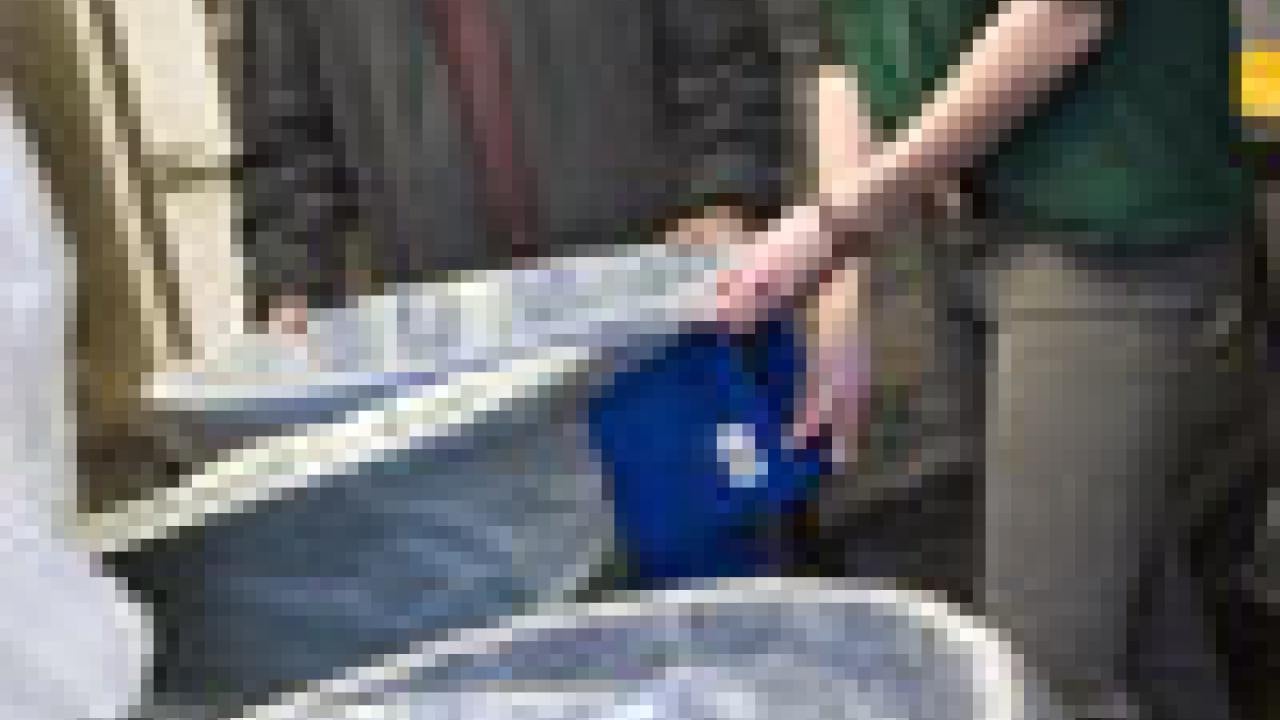You are done with your lunch in the Tercero dining commons, maybe leaving a half-eaten entrée, some salad and a couple of French fries on your plate. You load your tray onto the conveyor and you are on your way.
Your leftover food and even your paper napkin are going places, too. But not to the university's landfill.
The Tercero dining commons operator, Sodexho, puts all this organic waste through the mill, so to speak, starting with a grinder. Out of it come millions of little pieces of waste. They go into a pulper, which removes much of the water content.
The pulper spits the waste into ordinary garbage cans and, in November, the university started sending the pulp to Jepson Prairie Organics — a giant composting yard in Dixon.
There, in 90 days, the pulp turns into compost suitable for sale. Farmers and other buyers then put the compost on the very fields where some of it may have originated as food.
Talk about completing the sustainability circle!
That compost is helping grow the vegetables and fruit that are feeding local people, including the students who eat in the dining commons," according to Lin King, manager of the university's R4 Recycling Program, which worked with Sodexho to start the composting program. It is part of the university's Food Focus, which aims to cut the amount of food waste on campus.
UC Davis is the first campus in the UC system to start such an overall postconsumer composting program. Tercero is the first dining commons in the program; Oxford is next, and after that, Castillian and Segundo. R4 also hopes to include the Coffee House and Silo.
85 to 95 percent
Second-year student Erin McNichol, R4 Recycling staff assistant who helps coordinate the composting program, said she is "very happy" with the Tercero results. Out back of the dining commons, she pointed to a trash compactor about the size of a delivery truck, and said the compactor is not used for trash anymore — there simply is not enough.
It used to hold as much as 75 cubic yards of scrunched up garbage. Now the compactor holds organic waste only, including pulp and other food scraps. The university's Solid Waste Division hauls the waste to Dixon once a week — 13.64 tons in November alone, the waste from up to 2,500 meals a day.
(The dining commons each week continues to provide several barrels of preconsumer waste to Project Compost, where student volunteers turn out fertilizer for campus use.)
Tercero's efforts — counting compost contributions, boxes and other containers — convert to a total recycling rate of 85 percent to 90 percent, said Michael LaShure, Sodexho's dining service operations director at Tercero.
Stan Nosek, vice chancellor of the Office of Administration, complimented the Sodexho food management team for being "outstanding partners in our effort to introduce sustainability into every aspect of our campus operations and culture."
Starting up the Food Focus composting program was not as simple as it might sound. Said McNichol: "I think the only issue is getting it to stick, to ingrain in the staff where every little thing goes."
The people who work in cleanup constitute the front line. No longer do they simply scrape all waste from plates into the trash. Most everything goes into the grinder, but the cleanup crew must pick off those pesky pieces of plastic that will not break down into compost.
Examples are the plastic that holds the crackers you have with your soup or salad. Or Popsicle wrappers.
Coffee stirrers used to be a problem, but LaShure solved that one. He put out spoons — real spoons.
All the organic waste is scraped into a trough, where continually flowing water carries the waste into the grinder. "Think of it as a giant garbage disposal," LaShure said, only the waste is not going down the drain.
Instead, the ground-up waste goes into the pulper, and from there the waste drops into a biobag inside a plastic garbage can. The biobag is made from cornstarch, so it too is compostable.
Elsewhere in the Tercero kitchen, the cooks and other workers make sure that all the cans and bottles and boxes go into the proper recycling bins.
So, what is left for the trash? Well, plastic wrap and vinyl gloves and aprons. Styrofoam would go in the trash, too, if Tercero even used any — which it does not.
Before the launch of Food Focus composting, UC Davis already kept 45 percent of its dining area waste out of the campus landfill, King said. With the new program, that percentage certainly will go up.
"If we want to get to zero waste, we cannot do it with cans and bottles and paper alone," King said. "We have to do organics. We have to look at the waste stream that normally would be trashed." McNichol estimated that UC Davis could send as much as 1,000 tons a year to Dixon, once the composting program is in full operation.
But even as R4 and Sodexho work to boost the campus's composting output, they encourage students, staff and faculty to help cut the university's total waste flow. One place to do that is the dining commons, where students are entitled to take as much food as they want — but do not always finish it.
"People need to be careful about how much food they take," said Jon Gire, recycling coordinator for R4, "to take only as much as they will eat."
Leftovers — the food that never makes it to plates — do not always go to waste, LaShure said. Instead, he said, Sodexho gives many of the leftovers to the Yolo County Food Bank.
Media Resources
Dave Jones, Dateline, 530-752-6556, dljones@ucdavis.edu
